Switch Stance Kono (jibe entry)
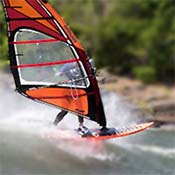
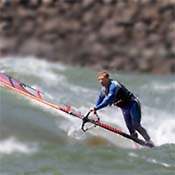
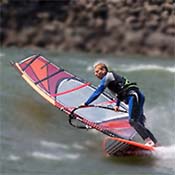
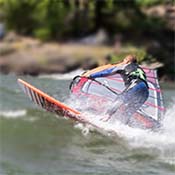
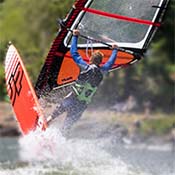
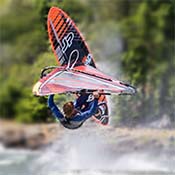
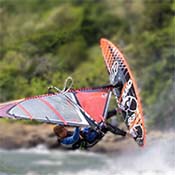
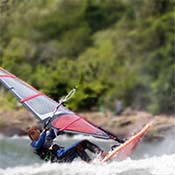
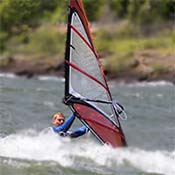
Steps
 1)
Start this maneuver as you would a powerful carving 360. In the Gorge, we have swell and small waves so look for a good and rolling swell. You will be using the swell as a downward slope for speed and then a ramp for air. Having moderate to strong winds helps but mastery of the maneuver enables you to perform this slightly underpowered as well. Flat water is more difficult.
1)
Start this maneuver as you would a powerful carving 360. In the Gorge, we have swell and small waves so look for a good and rolling swell. You will be using the swell as a downward slope for speed and then a ramp for air. Having moderate to strong winds helps but mastery of the maneuver enables you to perform this slightly underpowered as well. Flat water is more difficult.  2)
I move my mast hand slightly forward on the boom and I keep my board planing relatively shallow on the swell. In other words, I do not get too far in front of the wave because your board speed will die. Again, maintain BOARD SPEED.
2)
I move my mast hand slightly forward on the boom and I keep my board planing relatively shallow on the swell. In other words, I do not get too far in front of the wave because your board speed will die. Again, maintain BOARD SPEED.  3)
Continue carving the board smoothly with the front arm mostly extended and your body wieght more over the front rail than a typical carving 360. Keep the sail close enough to the water so that the sail does not get overpowered (the backwinding) and to throw you on your back. Strong winds will require the sail closer to the water and lighter winds will required the sail more off the water. Remember, BOARD SPEED is your friend. WIth practice you will learn how to control the power in the sail.
3)
Continue carving the board smoothly with the front arm mostly extended and your body wieght more over the front rail than a typical carving 360. Keep the sail close enough to the water so that the sail does not get overpowered (the backwinding) and to throw you on your back. Strong winds will require the sail closer to the water and lighter winds will required the sail more off the water. Remember, BOARD SPEED is your friend. WIth practice you will learn how to control the power in the sail.
 4)
As the board approcahes the top of the wave (I am guessing roughly at about 11 on the clock or 315 degrees) , I am loading up the sail and initiating the jump from a slightly crouched position.
4)
As the board approcahes the top of the wave (I am guessing roughly at about 11 on the clock or 315 degrees) , I am loading up the sail and initiating the jump from a slightly crouched position.  5)
Throw the boom above your head ( into the sky ) and jump at the same time. This is an explosive movement and you really have to huck the sail upward. The only exception is on super windy days where you will simply move the sail above your head so control can be maintained. Notice my body is extened trying to get as high as possible. You make or break the move at this critical point. And here is the BIG tip: PUSH OUT WITH THE BACK HAND as you throw it above your head.
5)
Throw the boom above your head ( into the sky ) and jump at the same time. This is an explosive movement and you really have to huck the sail upward. The only exception is on super windy days where you will simply move the sail above your head so control can be maintained. Notice my body is extened trying to get as high as possible. You make or break the move at this critical point. And here is the BIG tip: PUSH OUT WITH THE BACK HAND as you throw it above your head.  6)
Once in the air, the momentum takes over with the wind pushing the sail (backwinded) with everything rotating around the mast base. The carving board speed along with your sheeted out high jump will cause your rig to rotate.
6)
Once in the air, the momentum takes over with the wind pushing the sail (backwinded) with everything rotating around the mast base. The carving board speed along with your sheeted out high jump will cause your rig to rotate.  7)
As the sail rotates around you will begin a transition into sheeting in with the back hand and pulling the heels under your butt. This happens pretty naturally in high winds but in lighter winds you will need to exaggerate the ending.
7)
As the sail rotates around you will begin a transition into sheeting in with the back hand and pulling the heels under your butt. This happens pretty naturally in high winds but in lighter winds you will need to exaggerate the ending.  8)
Push the front hand forward (less in stronger winds, more in lighter winds) to get over the center line of the board and to get the sail as vertical as you can.
8)
Push the front hand forward (less in stronger winds, more in lighter winds) to get over the center line of the board and to get the sail as vertical as you can.  9)
During a well executed maneuver, you will land somewhat vertical and sliding backwards like Vulcan. Some will land with your butt in the water, and the weaker maeuvers will require a water start.
9)
During a well executed maneuver, you will land somewhat vertical and sliding backwards like Vulcan. Some will land with your butt in the water, and the weaker maeuvers will require a water start. Helpful Skills
Having a good Laydown Jibe and Carving 360 (In the Straps ) is very helpful for understanding the setup for this maneuver. A Wymeroo, Wave 360, or Goo Screw is very helpful in that they all have a similiar jump with an open sail. Knowing other huck maneuver is also helpful like forwards. Jumping/Popping the board is critical so good chop hopping and popping will aid learning this maneuver.
Tips
BOARD SPEED is super important so charge into the maneuver and do not get too deep into the swell. Above your head means vertical from the water into the sky. Because you are looking up, some sailors will throw the sail more backward rather than upward because of the head orientation and spatial awareneess.
Ideas
On really windy days I have over-rotated this maneuver so much that I think it is possible to huck a forward at the end of this move. I have tried one handed versions but have yet to land one. Maybe an attempt clew first is pssible. Landing a good one feels like the end of a Vulcan (backward sliding) so any variation at the end is possible.